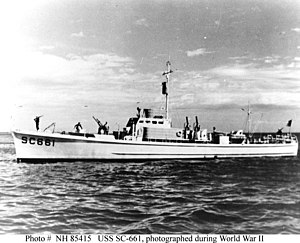SC-497-class submarine chaser
 USS SC-661
| |
| Class overview | |
|---|---|
| Operators | |
| Preceded by | Protoytpe submarine chaser USS SC-453 |
| Succeeded by | SC-1466 class |
| Built | 1941-1944 |
| Planned | 475 |
| Completed | 438 |
| Cancelled | 37 |
| Active | 0 |
| Lost | 17 |
| Preserved | 1 |
| General characteristics | |
| Type | Submarine chaser |
| Displacement | 98 tons |
| Length | 110 ft 10 in (34 m) |
| Beam | 17 ft 11.5 in (5 m) |
| Draft | 10 ft 10 in (3 m) |
| Propulsion |
|
| Speed | 15.6 or 21 knots (28.9 or 38.9 km/h; 18.0 or 24.2 mph) |
| Complement | 3 officers, 25 enlisted |
| Armament | Varies over time |
| Armor | Wooden hull |
The SC-497-class submarine chasers were a class of 438 submarine chasers built primarily for the United States Navy from 1941-1944.[1] The SC-497s were based on the experimental submarine chaser, USS SC-453. Production began in 1941 and continued until they were succeeded by the SC-1466-class submarine chaser in 1944.
History
The SC-497s were off-shore patrol and anti-submarine warfare vessels. Seventy of the SC-497s were converted into patrol control crafts (SCC), 18 were converted into coastal minesweepers (AMC), and 8 were converted into patrol gunboats, motor (PGM).[2]
Sixteen SC-497s were lost and another one was lost after her conversion into a Template:Sclass-.[2][3]
Despite the large number of SC-497s, none are credited with destroying an enemy ship. (USS SC-669 is sometimes incorrectly credited with sinking the Japanese submarine RO-107 on 29 May 1943,[2] but RO-107 was still active on 6 July 1943.[4])
During World War II, 142 SC-497-class submarine chasers were lent to allies of the United States as part of the Lend-Lease program. Seventy-eight were sent to the Soviet Union, 50 to France, 8 to Brazil, 3 to Norway, and 3 to Mexico.[2][1] The three Norwegian examples served with distinction on the Shetland bus service, running agents, refugees and weapons past the German blockade between occupied Norway and Britain.
Survivors
HNoMS Hitra (ex-USS SC-718) is preserved at the Royal Norwegian Navy Museum. Some remains of HNoMS Hessa (ex-USS SC-683) and HNoMS Vigra (ex-USS SC-1061) can be seen near the coast of Sweden.
See also
References
- ^ a b c d Information on WWII SCs, retrieved 21 March 2009
- ^ Submarine chasers: SC-497 class, retrieved 21 March 2009
- ^ HIJMS Submarine RO-107: Tabular Record of Movement, retrieved 21 March 2009
